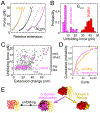The Ribosome Cooperates with a Chaperone to Guide Multi-domain Protein Folding
- PMID: 30852061
- PMCID: PMC6481645
- DOI: 10.1016/j.molcel.2019.01.043
The Ribosome Cooperates with a Chaperone to Guide Multi-domain Protein Folding
Abstract
Multi-domain proteins, containing several structural units within a single polypeptide, constitute a large fraction of all proteomes. Co-translational folding is assumed to simplify the conformational search problem for large proteins, but the events leading to correctly folded, functional structures remain poorly characterized. Similarly, how the ribosome and molecular chaperones promote efficient folding remains obscure. Using optical tweezers, we have dissected early folding events of nascent elongation factor G, a multi-domain protein that requires chaperones for folding. The ribosome and the chaperone trigger factor reduce inter-domain misfolding, permitting folding of the N-terminal G-domain. Successful completion of this step is a crucial prerequisite for folding of the next domain. Unexpectedly, co-translational folding does not proceed unidirectionally; emerging unfolded polypeptide can denature an already-folded domain. Trigger factor, but not the ribosome, protects against denaturation. The chaperone thus serves a previously unappreciated function, helping multi-domain proteins overcome inherent challenges during co-translational folding.
Keywords: elongation factor G; molecular chaperones; multi-domain protein; nascent polypeptide; optical tweezers; protein folding; protein synthesis; ribosome; single-molecule; translation.
Copyright © 2019 Elsevier Inc. All rights reserved.
Conflict of interest statement
DECLARATION OF INTERESTS.
The authors declare no competing interests.
Figures







Similar articles
-
The ribosome destabilizes native and non-native structures in a nascent multidomain protein.Protein Sci. 2017 Jul;26(7):1439-1451. doi: 10.1002/pro.3189. Epub 2017 May 19. Protein Sci. 2017. PMID: 28474852 Free PMC article.
-
Energetic dependencies dictate folding mechanism in a complex protein.Proc Natl Acad Sci U S A. 2019 Dec 17;116(51):25641-25648. doi: 10.1073/pnas.1914366116. Epub 2019 Nov 27. Proc Natl Acad Sci U S A. 2019. PMID: 31776255 Free PMC article.
-
Synthesis runs counter to directional folding of a nascent protein domain.Nat Commun. 2020 Oct 9;11(1):5096. doi: 10.1038/s41467-020-18921-8. Nat Commun. 2020. PMID: 33037221 Free PMC article.
-
How Does the Ribosome Fold the Proteome?Annu Rev Biochem. 2020 Jun 20;89:389-415. doi: 10.1146/annurev-biochem-062917-012226. Annu Rev Biochem. 2020. PMID: 32569518 Review.
-
Single-Molecule Studies of Protein Folding with Optical Tweezers.Annu Rev Biochem. 2020 Jun 20;89:443-470. doi: 10.1146/annurev-biochem-013118-111442. Annu Rev Biochem. 2020. PMID: 32569525 Free PMC article. Review.
Cited by
-
Life under tension: the relevance of force on biological polymers.Biophys Rep. 2024 Feb 29;10(1):48-56. doi: 10.52601/bpr.2023.230019. Biophys Rep. 2024. PMID: 38737478 Free PMC article.
-
Ligand Binding Site Structure Shapes Folding, Assembly and Degradation of Homomeric Protein Complexes.J Mol Biol. 2019 Sep 6;431(19):3871-3888. doi: 10.1016/j.jmb.2019.07.014. Epub 2019 Jul 12. J Mol Biol. 2019. PMID: 31306664 Free PMC article.
-
CFTR trafficking mutations disrupt cotranslational protein folding by targeting biosynthetic intermediates.Nat Commun. 2020 Aug 26;11(1):4258. doi: 10.1038/s41467-020-18101-8. Nat Commun. 2020. PMID: 32848127 Free PMC article.
-
Next generation single-molecule techniques: Imaging, labeling, and manipulation in vitro and in cellulo.Mol Cell. 2022 Jan 20;82(2):304-314. doi: 10.1016/j.molcel.2021.12.019. Mol Cell. 2022. PMID: 35063098 Free PMC article. Review.
-
Mechanistic Insights into Protein Biogenesis and Maturation on the Ribosome.J Mol Biol. 2025 Feb 28:169056. doi: 10.1016/j.jmb.2025.169056. Online ahead of print. J Mol Biol. 2025. PMID: 40024436 Review.
References
-
- Agashe VR, Guha S, Chang HC, Genevaux P, Hayer-Hartl M, Stemp M, Georgopoulos C, Hartl FU, and Barral JM (2004). Function of trigger factor and DnaK in multidomain protein folding: increase in yield at the expense of folding speed. Cell 117, 199–209. - PubMed
-
- Anfinsen CB (1973). Principles that govern the folding of protein chains. Science 181, 223–230. - PubMed
Publication types
MeSH terms
Substances
Grants and funding
LinkOut - more resources
Full Text Sources
Other Literature Sources
Research Materials

